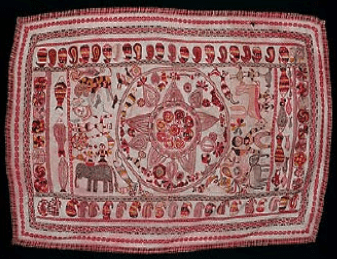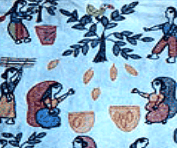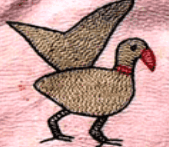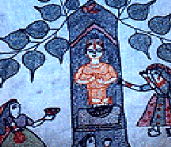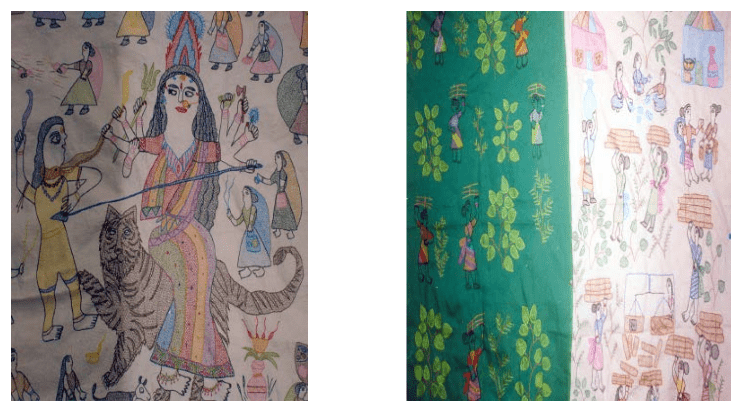Are you looking for sujni embroidery then check out this post to know more. The Sujni of Bihar is very similar to the Kanthas of Bengal. Initially Sujni was made for traditional purposes.
At the time of child birth, patches of different coloured cloth from old saris were sewn together with a simple running stitch to make a quilt called Sujni. But Sujni production had virtually disappeared until it was revived in 1988 by ADITHI and its products adapted to urban market.
ADITHI works through the Mahila Vikas Sahyog Samiti (MVSS), a small autonomous society, based in Bhusura Dist. of Mujaffarpur, Bihar.
The difference between Sujni and Kantha Sujni is very similar to Kantha because both are made of old materials and embroidered with the thread unpicked from borders of saris.
But they differ in techniques:
- In Sujni, running stitch worked in straight line but in Kantha they use spiral, circular and conical forms.
- In Sujni the outline of the motifs are done by chain stitch in dark colour but in Kantha out lines are done by running stitch.
- In Sujni the motifs are filled with running stitch and rest of the area is also embroidered by the running stitch with the same base colour thread but in Kantha only motifs are filled.
Sujni Embroidery the Hindu
History
The history of this craft dates back to 18th century. People at that time utilized old materials like saris or dhotis to make quilts and other utilitarian products for new born babies.
The design of these products interprets a mother’s emotion and imagination regarding her baby. In these quilt the design depicts the mother’s dream for her new born. It is made by old materials like saris or dhotis.
Saris or dhotis in this area are predominantly white and borders are in black or red or blue and sometimes yellow or blue. Three or four section of saris or dhot is laid on top of each other and then quilted with the thread unpicked from borders of saris or dhotis.
The filling of the motifs is done by simple running stitch and the outline of the motif is usually done in chain stitch in dark colours filled with running stitch.
Sujni production in India
Sujni is practiced in different part of Bihar like Patna, Madhubani, Muzaffarpur
Producer communities
Initially expecting mothers of all the communities use to make Sujni for their child. But now women of all community, mainly below the poverty line are engaged in this craft.
Nirmala davi was the first women to take the initiative in the Sujni project under the Mahila Vikas Sahyog Samiti. Today about 600 women from 22 villages around Bhusura are working under this project.
Raw material
Cotton
• SALITA: It is used as base of the embroidery. Salita is a very good quality cotton and mainly used for export.
• WHITE OR COLOURED MARKEEN: This is not of very good quality and mainly used for the exports market.
• CASEMENT: It is used for wall hanging and cushion cover. Tussar silk It is used for saris, dupattas, or dress materials.
Embroidery Thread
• MOON THREAD: Moon thread is used for back ground filling. The color of the thread is similar to the base colour.
• RANGOLI OR ANCHOR THREAD: It is used for filling of the motif and the outline of the motif.
Tools used
•NEEDLE: 9 number needles is used for embroidery.
•FRAME: Frame is used for tightening the cloth. It helps in avoiding the wrinkles.
•SCISSORS: is used for giving finishing touch and cutting the extra knots and threads.
•INCH-TAPE: Inch tape issued for measuring the cloth and marking when design isdrawn.
Process of sujni embroidery:
Following steps are followed during the making of Sujni:
• DRAWING AND TRACING: The outline of design is traced or drawn directly on to the cloth by the women. Stories, compositions and colour combination are worked out by the women on their own.
EMBROIDERY:
The back ground is filled with the fine running stitch with thread whose colour is similar to the back ground. It gives a wavy effect.
Chain stitch usually in black, brown and red thread is done for the main outline of the motif and the design is then filled with running stitch in coloured threads.
Sujni embroidery is very simple but requires a lot of patience and time. The smaller items can be made individually and to make large bed sheets or quilts, three or four women work together, starting from different ends approaching towards the centre.
• FINISHING: In this process all the extra threads or knots are cut from the edges to give it better finishing.
• WASHING AND CALANDRING: When the embroidery work is finished then the article is properly washed and then calandered.
• PACKAGING AND LABELING: Finished products are properly labeled with the brand name ‘Sujni’ and price tags. They don’t have special packaging for the product, if they give special packaging, the cost would increase.
Range and uses of the product
In Sujni embroidery artisans make bed sheet, cushion cover, wall hanging, sari, dupatta, suit, top, kurta pajama, shirt and bag. Sujni products are used for decorative as well as utilitarian purposes.
Marketing
With the improvement in marketing facilities and assistance from ADITHI, the market of Sujni has grown from national level to international level. Now Sujni can be seen in local haats, as well as in exhibitions, design stores, export stores.
They are earning a lot from the exposures they received from craft fairs, exhibition overseas, and at national level also with the brand name ‘Sujni ’.
•FINANCIAL MARKETING ASSISTANCE: In marketing, Sky Morisan was first lady who supported Sujni embroidery in export market. And also in National market Sujni embroidery is supported by Government and NGOs.
•LABOUR COST: Because of the intricacy in the work, labor cost of Sujni is very high. Now Sujni has become a product for Niche market. In India only some people are able to buy this craft and mainly it is made for export market.
Changes in recent years
• TECHNOLOGY: Initially in Sujni they used old materials like sari or dhoti .Different layers were sewn together to make the whole but today only one sheet of new materials like salita, markeen, casement and tusser silk issued.
• DESIGN: Initially the design used to depict daily life, flowers, trees, flying birds, fishes, elephants with rider, deities whose attributes are reflected in various ways- the energy emanating from Durga manifesting itself through quality of the hair of the tiger on which she rides.
But today design depict details of village life and Hindu epics, social issues like female infanticide, election violence, education of girl, scenes of domestic abuses dominate the designs. Lessons of health care, parables about environment and images of women struggling for their right are very empowering. This is very interesting and encouraging because it comes from Bihar, where dowry cases and instances of female infanticide are widely prevalent.
MARKET:
Initially Sujni was made only for personal use but today Sujni has created a national and international market. However, Sujni is facing lot of competition from Kantha and other embroidery crafts.
WOMEN STATUS:
Today Sujni craft is seen as an important source of income for women. It has also played a major role in rural society. Initially, women rarely left their homes, men and women did not interact at all and physical violence against women was common. Now because women are working and are becoming independent they move around, interact with men and protest against abuse and ill-treatment.
Problems faced by the craftsmen
•In Bihar flood is a major problem and poor people suffer a lot due to lack of basic infrastructural facilities.
Bhusara and surrounding villages are only practicing Sujni as they are getting financial and marketing assistance from ADITHI. But in the remaining areas the craft is dying due to lack of money and other basic necessities.
Lack of education is also a main problem for this craft, the artisans don’t know how to market their products.


